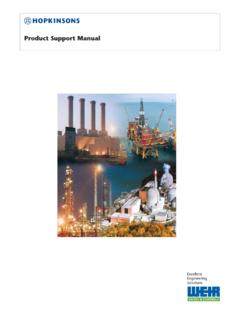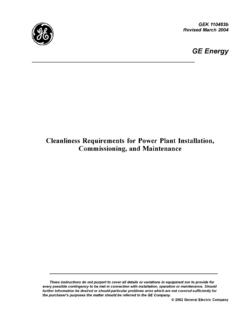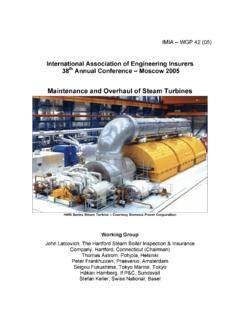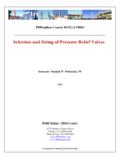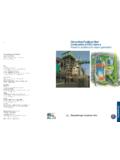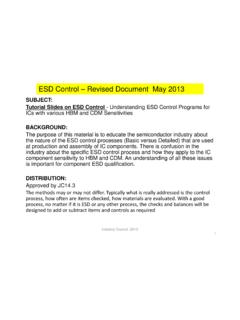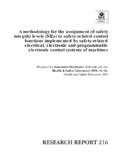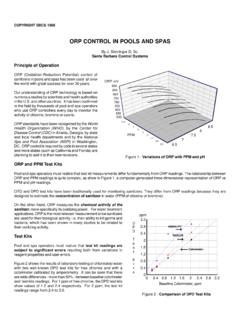Transcription of Boiler Water Treatment Chemicals, Feed, and Control ...
1 Boilers 170 Boiler Water Treatment Chemicals, feed , and Control - Perhaps It Is More Complicated Than We Thought By Dave Christophersen, CWT Originally Presented: Association of Water Technologies 2006 Annual Convention & Exposition, September 15, 2006 Chemicals used to treat steam Boiler systems are applied based upon the demand and mode of reaction of each chemical used. The theoretical versus actual consumption and the ease of Control of these chemicals can vary according to many factors specific to each application. Dosages and controls of chemicals are affected by how and where they are fed. The reaction and residual part of the chemical dosage calculation equation can affect Control and results. Looking at the reaction percent helps decide whether it will work. The residual percent tells how easy it is to Control . If all waters, all pretreatment equipment, all condensate, all feed equipment, all operators, and all boilers were the same, the chemical Treatment would become routine, rather simple, easy, and reliable.
2 However, since each steam system is unique in many ways, there are plenty of opportunities to provide application expertise by understanding each specific condition and the associated problems. There are several different chemical approaches used to treat boilers and their selection and performance depend upon many factors. Some of these include: 1. Feedwater characteristics. 2. The type and reliability of external Treatment . 3. Boiler type. 4. Boiler pressure and heat flux. 5. Steam load and variations in load. Boilers 171 6. Waterside condition of the Boiler and current and long-term goals of the program such as cleaning up scale or maintaining present conditions. 7. Client and service provider preference. 8. Steam purity requirements. 9. Regulatory restrictions such as FDA requirements, other health and safety concerns, or process restrictions. 10. feed , testing, and Control needs or restrictions. 11. Economic considerations. 12. Boiler room layout and number of boilers. The dosage of sodium sulfite or other oxygen scavengers may be calculated by looking at their reaction rate to remove the oxygen and then their residual dosage to provide a feedwater or Boiler Water residual.
3 Sodium Sulfite Example The reaction rate is: 2Na2SO3 ( ppm) + O2 ( 1 ppm) 2Na2SO4 For the residual, ppm Na2SO3 will yield 1 ppm SO3. The total calculation equation to remove residual oxygen and provide a Boiler Water residual is: (Feedwater O2 x ) + ( x Boiler Water SO3 Residual) / Feedwater Cycles = Feedwater Dosage of 100% sodium sulfite in ppm. Spreadsheets can be made as shown at the end of the article that illustrate the impact of changes in variables such as dissolved oxygen concentration, feedwater cycles, steam production, desired sulfite residual, and applied dosages. Examine the results shown on the examples. If the dissolved oxygen concentration varies from ppm to ppm in the feedwater, to maintain the 30 ppm Boiler Water residual, the daily dosage demand increases by almost 500% and the reaction demand increases from of the dosage to 80%. Clearly a variable oxygen content is very difficult and costly to Control . Looking at cycle Control reveals that even though the dosage to obtain a residual may increase dramatically at low cycles, only a small portion of the sulfite total dosage is required to remove oxygen, so residual Control is not as important if the deaerator is operating properly.
4 The reaction dosage at 5 to 50 cycles only varies from to of the total required dosage. Changing the residual in the Boiler if the deaerator is operating properly can change consumption significantly, but should have little impact on results, unless the deaerator dissolved oxygen level spikes above the ppm level. Boilers 172 Variations in deaerator oxygen removal obviously would have a great impact on sulfite consumption. If the dosage is fixed at ppm at 25 cycles, and the oxygen content from the deaerator increases from ppm to ppm, the sulfite residual will drop from 29 ppm to 18 ppm. The reaction demand increased from of the total dosage to 41%. Clearly, the Control of sulfite feed and maintaining Control will depend upon the specifics of each system. A deaerator that provides consistent, low oxygen residuals will be much easier to Control than one that is giving unsteady results. Feedwater heaters with variable oxygen levels will be nearly impossible to Control economically.
5 Where dissolved oxygen levels are high or variable and when using feedwater heaters, applying a passivator such as erythorbate or DEHA would be a valuable addition to the sulfite. Sodium Hexametaphosphate Sodium hexametaphosphate is a commonly used source of orthophosphate anion used to precipitate calcium in low-pressure boilers. With dispersants the calcium phosphate becomes a fluidized sludge capable of being blown down and out of the Boiler before the calcium can form a deposit. Example The reaction rate is the first part of the equation and the residual the second part: [ ( x Ca + x PO4/ Feedwater Cycles) ] = ppm of 100% sodium hexametaphosphate in feedwater. Again, spreadsheets can be made varying calcium in the feedwater, cycles, steam load, changing desired phosphate residuals, or holding the phosphate dosage constant. Examining the spreadsheets reveals that if the feedwater calcium level is low, most of the product dosage goes to provide residual in the Boiler Water . If the calcium level starts to become significant, the reaction portion of the equation may become the major demand for the product.
6 Obviously, Control will be difficult with variations in feedwater calcium just as with variation with oxygen for sulfite Control . If the feedwater cycles are varied from 5 to 50 cycles, the dosage requirement changes by over a factor of 8, with most of the demand coming from the residual portion of the calculation. So even though residual may change significantly, if calcium is low and consistent, there is enough phosphate to satisfy the demand, and calcium carbonate scale should be avoided even with wild changes in blowdown rates. Boilers 173 Chelant Treatment EDTA dosage requirements and variations will be similar to phosphate in that there is a reaction and residual portion to the dosage calculation: (Feedwater hardness) x ( ) + ppm EDTA desired residual = ppm EDTA Product % active (feedwater cycles) x % active 100 100 Economical Control would again be very difficult with fluctuations in feedwater hardness.
7 Looking at the spreadsheet at the end of the paper shows that the EDTA dosage demand can easily increase twenty-fold with poor feedwater hardness Control . Phosphate Treatment would be easier to Control with variations in feedwater hardness. Blended Products The variation in phosphate demand or chelant demand and changes in cycles makes phosphate/polymer or chelant/polymer blends difficult to Control . These products are best designed for a specific and consistent condition. A formulated product should be evaluated for each system and anticipated fluctuations to see how the polymer level varies if phosphate or EDTA is used as the Control . Example A Boiler product contains 10% EDTA and 15% polymer. It is applied to a Boiler operating at 20 cycles with ppm feedwater hardness. Feedwater dosage is ppm to yield 10 ppm free EDTA and 26 ppm polymer. If the hardness goes up to 1 ppm or the product is used in another system where the hardness is 1 ppm, the feedwater dosage increases to 43 ppm to obtain 10 ppm free EDTA.
8 This would yield a high polymer level of 129 ppm. Polymer overfeed is expensive and high polymer levels can cause Boiler Water carryover with their surface-active properties that occur at high concentrations. Other chemical feed and Control Considerations How and where the various Boiler chemicals are fed can affect their performance and Control . a. Oxygen scavengers are best fed to the storage section of the deaerator or feedwater tank. In most low-pressure industrial Boiler systems, if oxygen remains in the feedwater and enters the Boiler , it is too late to remove all of the oxygen and protect the Boiler and condensate from oxygen corrosion. A residual of sulfite or other Boilers 174 oxygen scavenger in the Boiler cannot chemically reduce all of the oxygen before it escapes with the steam or reacts with the metal surfaces. The oxygen scavenger should be pumped either continuously or paced with makeup into the deaerator so that there is a positive residual at all times in the deaerator.
9 Consideration should be given to see where the makeup and condensate enter the deaerator. Often times the high pressure condensate enters directly into the storage section. If the condensate contains oxygen, intermittently high dissolved oxygen levels in the feedwater may occur. Also sudden load changes can allow temporary high dissolved oxygen levels. Even with sulfite feed to the deaerator, but especially if sulfite is fed to the Boiler , the Boiler sulfite residual may not show a big change as oxygen is released into the steam or corrodes the Boiler before it is reduced chemically. Dissolved oxygen testing in the feedwater would be the best tool to insure consistently low dissolved oxygen levels and adequate chemical feed and Control . How condensate is returned, the level controls on the deaerator, and the proportion of makeup to condensate can affect deaerator performance and therefore results. If there is a relatively small deaerator volume and the amount of condensate return varies throughout the day or night, load and performance can change.
10 Dissolved oxygen content and feedwater oxygen scavenger concentration should be checked under the changing conditions. These situations could explain why one system sees corrosion and another does not, even though it appears to be the same Treatment and Control . b. chemical feed should be continuous. chemical pumping rates can create problems especially for neat feed set ups. Using on/off feed systems such as a recycle timer can create problems. chemical feed pumps should be sized or product strengths should be adjusted to allow continuous feed . Steam and carbon dioxide leave continuously, so setting up a neutralizing amine pump to feed intermittently can lead to wide variations in condensate pH Control . If sampling is done from a condensate receiver, the tank volume may buffer the variations and the changes may not be noticed, but corrosion could be occurring to areas of the piping that see the rapidly changing pH. Boilers 175 If polymeric dispersants, phosphonates, phosphate, or chelants are fed intermittently into the feedwater using a recycle timer, and the amines are not fed continuously, a cycle of iron slugs returning in the condensate can be followed by slugs of high dispersancy cleaning of the iron from the deaerator and dragging it into the Boiler .
